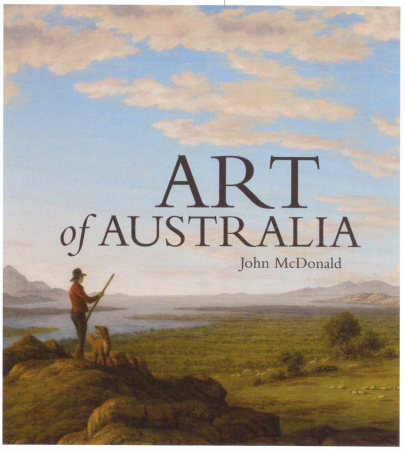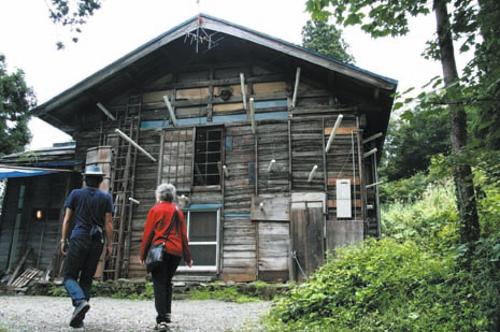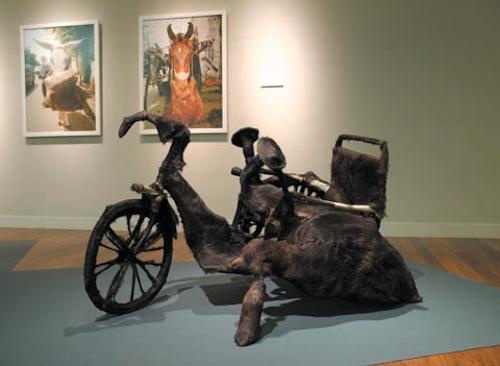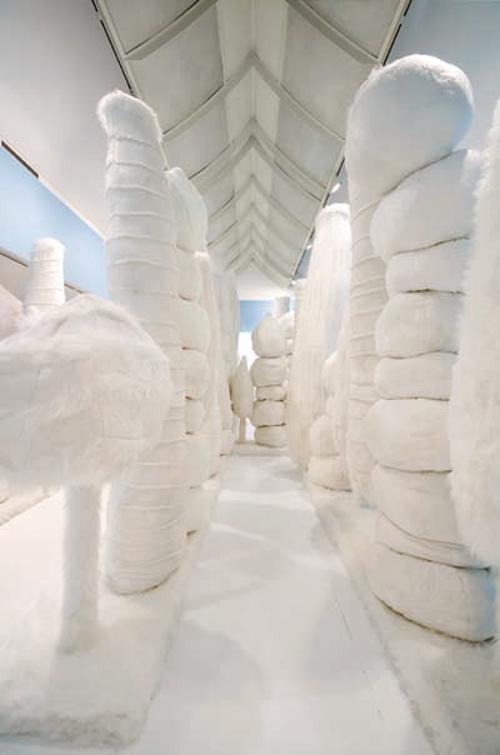
It's a big book. At the very least it should have births deaths and marriages recorded in its frontispiece, it should lay on the back of a brass eagle, it should be held up in two hands to the overawed populace, kissed with reverence, carried through the streets in the midst of dancing, chanting men or lie under dusty glass, with shellac dipped olive leaves cut from green fabric. But no - it is simply one of the most physically heavy histories of Australian art ever to come off the presses.
The mere fact that there are more large-scale coloured pictures of a greater range of historic artists than ever before bestows upon it the virtues of usefulness and accessibility and if the book finds its way into school and municipal libraries it will be doing good service in alerting readers, particularly those who don’t go into major public galleries on a regular basis, to the extended compass of nineteenth century settler art. Although like prescription medicines it could be dangerous in unknowing hands and thus it must remain a mixed blessing.
In its size and its general weight and resistance to being hand-held there is already a strong enough story of white culture in Australia that one need not even critique the contents. Once in the 1970s Australian art history could, in a plainer and more self-contained construct, be contained within single volumes or linked volumes of modest size. These books often had such stirring titles as The Restless Years, Civilised Magic, From the Deserts the Prophets Come and were written by men such as James Gleeson, Bernard Smith, Graham Hopwood, Robert Hughes (his was the version that had the maliciously funny jokes – the passage about Norman Lindsay and Picasso remains a classic). It is time for a new book. A lot has changed in Australia since then both in art history and society. The vast difference from those small books with their limited pictorial component (often only in black and white and usually often little larger than a playing card) and this gigantic tome with its sumptuous parade of nearly full page images equally matches the differences in the society that produced them. In many ways McDonald’s history of Australian art is the book for our portentous times, money still flows incontinently for some, as far as the evidence of citizen’s behaviour suggests, despite the recession, when old modest shacks are bulldozed for McMansions; thousands attend annual memorial services in Gallipoli and Villiers Bretonneux. Canberra may have rejected the avenue of international heroes of science proposed for the Academy of Science, but now has its own Siegesallee lined up between Parliament House and the War Memorial and Time magazine mocks our leader as Global Guy who speaks Mandarin and tries to be mates with the whole of the world. This flashy, obviously dramatic production reflects this changed sensibility with a remarkably perfect fit.
Within art historical knowledge likewise much has changed in the last four decades, since consensus assumed that one could encompass the art of settler Australia in a single volume or set of modest surveys – with the possible exception of the Beagle Press where it is still business as usual with culture in the hands of senior curators and writers and collectable safe artists of acknowledged quality. McDonald’s survey does register these revitalised public collections and the nature of their changed displays. The new visibility of Von Guerard has not been formally captured in a generalist mainstream history before. The understanding of art provided by public collections has been transformed, particularly with the new NGA and the coming to prominence of the AGSA, both galleries being particularly assiduous in their revisions and expanded visions.
The proliferation of auction houses over the last three decades also has played its part. Many more paintings of national significance than the stock classics illustrated in the old books have emerged and often found their way into the changed public collections. There have been two, perhaps three, major auction room booms around Australian art in the interim. The art market’s favourites are as personalised and arbitrary as the general narrative here, with clear anxieties about winners and losers and with the undisguised favouring of that deemed to be good this history very much shares the art market’s values. However McDonald and the art market part company over Bunny, about whom he is fairly lukewarm and of whom the auction houses cannot get enough examples.
Without being too intertextual one may note that other reviews have castigated this particular title for colonising the vision of others and standing upon the shoulders of known works of revisionist historians, especially curators whose writings are mainly published in-house as catalogues and thus miss a sizeable proportion of general readers. This is a tangible fault of the popular and public intellectual discussion of the visual arts in Australia, although the fault should be slated not to McDonald per se but to the publishing, publicity and celebrity industries that demean and delimit the expression of culture in Australia, by packaging and preselecting cultural choice. So much of the mainstream quality media, the ABC and the tabloids, the promotion of ideas via literary festivals and symposia, is closely tied up to publicists’ releases or newsfeeds from publishing companies.
Commercial publishers in Australia frequently seem to believe the most appropriate and reliable apprenticeships for writing any professional text from novels to art histories is via journalism, and those writers embedded within the nuances of the field have nothing to offer. Thus too the support for this book from the Australia Council, whilst perhaps disappointing, is not surprising, given the importance of reliable product and precedent in establishing a public discourse of 'excellence’, and the manner in which Australian patronage prefers to default to the known than set out on a more speculative course. This sense of ingroup and outgroup is of course central to the interpretative methodology of the whole text.
And how to deal with the text as a whole, given that I think the circumstances that produced it are flawed, and given that the possibility of an alternative position or product emerging are virtually zero in the immediate future and, that it will acquire a natural authority that it does not fully merit. With such a large spread it becomes hard to encapsulate the complete text.
Does one indicate how it confirms one’s own prejudices that much of the early 19th century art looks provisional, scrappy and essentially flat and dull before Von Guérard, or is one merely sensing McDonald’s own sense of relief when he is able to stray into the Elysian Fields of the mastery of Messrs Guérard, Roberts and Streeton, with everyone else but accessories to the fact? Does one award ticks for the times that McDonald agrees with one’s own thinking – the rightful demotion of Martens, Buvelot and Withers as artists of relatively unengaging and repetitive oeuvres, whereas S.T. Gill is lavished with more praise than in living memory, an interpretation that I find less cogent. McDonald also rightly questions some of the spectacular attributions and reattributions of colonial paintings, driven by curators and dealers, and disputed by empiricist historians demanding more documentary proof. McCubbin particularly is regarded dispassionately for his sentimentality and the lack of intellectual grounding for his vision, which is a substantially viable position to take, but surprising in light of McDonald’s hagiography of Streeton, Roberts and Conder.
Bad art causes cancer
Does one take issue with the almost visceral denunciation of artists rated as unimportant, particularly women artists? The vehemence of the language is out of all proportion to the threat posed. There is a visceral quality to the emotions like those of bogan men haranguing radio talk show vets over any hint of a suggestion that they should neuter their dogs. Good art is a protection from death and oblivion, bad art causes cancer, global warming and child prostitution. There is a reluctance to acknowledge that women artists had anything viable to say about aesthetics or the world around them, the only evidence that they provide is that of their manifest not-goodness and the equally deluded efforts of their advocates. Like a dog rushing across a busy road to bite the leg of someone walking on the opposite pavement, McDonald seems to put great effort into ensuring that he emphasises the poor quality of artworks by women, although he devotes some lines to the fascinating story of Artur Loureiro’s sister-in-law the (slightly sub Jamesian) Australian novelist and essayist Tasma, but of course women are allowed to be great writers. Even images of women and girls seem to cause offence including Wainwright’s Cutmore Twins, Roberts’ portraits of little girls and Martha Berkely’s portraits of her daughters: ‘sweet’ is definitely a word of serious insult. However most artists male or female, pale into insignificance as mere support figures to McDonald's designated heroes.
Does one highlight the singular inconsistencies, particularly the manner in which the book seemingly proffers an improved up-to-date history but also remains set in old modernist ruts? The stance upon academic art as a priori evil was already shifting overseas in the 1970s, but McDonald still confidently states the unworthiness of representational ‘academic’ art in relation to mildly continental-inspired ‘impressionism’, marking a strongly provincial twitch in Australian art writing, which has rendered cosmopolitans such as Mackennal and Bunny ambiguous subjects. Statements about the irrelevance of academic art and the dismissing of narrative in visual art, would now be firmly corrected overseas in first year art history, but persist here for nearly half a century after they have lost cogency internationally. Sculpture as always is relegated to silly mid off, popping up occasionally and disappearing again.
Or does one highlight distinctly progressive tendencies in the history such as the assimilation of popular prints and press-based media, as well as photography, into the high art narrative, and the grounding of painting into the cross references provided by recent Australian historians, although dampening down the Left wing take of university history schools into a more popularist self-congratulatory apolitical celebration of ‘Australia’, a country that is basically familiar and loved?
McDonald’s breadth of vision helps persuade us that the visual arts matter. No other art history reminds us that long before Kylie Australian culture went global with Erich von Däniken using Indigenous rock art as evidence for his high profile parascientific theories on extraterrestrials in the late 1960s. Nor could any other known art writer suggest that First Fleet Convicts and Costa Del Sol tourists both recognised no cuisines other than British or that Sydney in the 1880s had not yet developed its self- satisfied indifference to the rest of the world, or liken a window in the Sydney Town Hall to a cover design for sword and sorcery fiction. McDonald’s art history is more engaged with everyday life in Australia than with auction houses or boardroom conferences in terms of its metaphors and thus is quite different from any previous iteration in its hedonistic populism. He also reviews his predecessors’ errors of attribution and evaluation, particularly highlighting the limits of past interpretations around minor landscapists when Australian scholarship is generally sycophantic towards the discipline leaders. Yet the path that he treads, despite these sparkling moments of rethinking and his disdain of paintings that are conventional and dull, often seems greatly overdetermined and as dull and known as the oeuvre of Buvelot.
The emotional core of the book, despite the fearful tone of writing about women artists and gender/virility paranoia, is love. ‘Do you believe in the revolution’ Joy Hester asked Sunday Reed when they opened their first conversation ‘I believe in love’ said Sunday. So too does John McDonald, that is love for the Heidelberg School and its paintings, which glow off page after page, many of which are still unfamiliar for a general audience, whilst McDonald loses himself in describing their paint surfaces, quoting their letters, charting the manner in which they changed their generation’s options and set the pace for their colleagues. His engaged prose presents not only some of the most charismatic writing about the group in recent years, but also the Heidelberg School as a de facto victory over death like a risen Christ in a medieval painting; all opposition melts away in the face of their given excellences. These elaborate assertions are presented as a fait accompli without any counter point of view other than an Olympian assertion of the manifest superiority of their artworks.
The tone is so intense that art theory almost tumbles into fiction so closely does the writer seem to be at hand to analyse the subjective motivation of the artists, and to construct emotional personae around these compelling yet elusive figures. McDonald is one of the first to highlight the unflattering oddness of the nickname ‘Smike’, named for a crippled invalid, who clung to Nicholas Nickleby in Dicken’s novel of the same name (and now often read as an early and sentimental but supportive portrait of a disabled person), for the later elegant and assured Streeton. The detailed and vivid account of the Heidelberg School’s activities and art, the lengthy quotations of firsthand writing, brings an intimacy at odds with the vast structure in which it is set, the camera focusing on hot teenage lovers embracing in a corner of the airport terminal.
If I was wondering how one can symbolically encapsulate a post-Howard Australia, there is no need to look further than McDonald’s history which synthesises the stylistic gestural fluidity of Rudd and Howard’s defence of a mythic confected Australian past, secure, serene, male and mateship driven. In some ways this volume is as miraculous and portentous as its size may suggest.
One may wonder what the second volume will bring, as there are more stories, more artists, more media, more contradictions, more pitfalls for a conventional modernist triumphalism after the turn of the century. The will to order will be harder to maintain.












